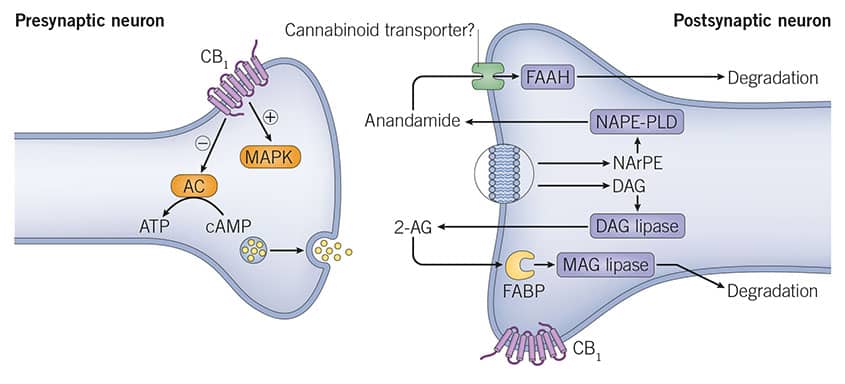Cannabinoid Transporters
Cannabinoid transporters, often referred to as anandamide membrane transporters (AMTs) or endocannabinoid membrane transporters (EMTs), are thought to facilitate the reuptake of endocannabinoids into cells. However, their existence as a neurotransmitter transporter is controversial and no transmembrane protein transporter or gene encoding a transporter has been identified to date.
Cannabinoid Transporter Inhibitors |
|
|---|---|
| Cat. No. | Product Name / Activity |
| 1116 | AM 404 |
| Anandamide transport inhibitor | |
| 1570 | (-)-Cannabidiol |
| AMT inhibitor; also GPR55 antagonist, weak CB1 antagonist, CB2 inverse agonist; natural cannabinoid | |
Cannabinoid transporters, or AMTs, transport endocannabinoids into cells and limit their activity at CB1, CB2 and GPR55 receptors. The action of these putative neurotransmitter transporters facilitates endocannabinoid breakdown by internalizing the molecule and allowing access to fatty acid amide hydrolase (FAAH).
Two endocannabinoids, Anandamide (also known as AEA, Cat. No. 1339) and 2-arachidonoylglycerol (2-AG, Cat. No. 1298), have been identified and since they are widely distributed, it has been suggested that AMTs should be present in many different tissues, although this has yet to be verified. Cannabinoid transporters are thought to play a vital role in the endocannabinoid system, and there is evidence for their existence from cell uptake studies and the physiological effects of inhibitors. However, some cannabinoid transporter inhibitors have been found to be FAAH inhibitors and endocannabinoids can pass through cell membranes without the need for a protein transporter owing to their lipid nature. Since endocannabinoids are lipids, carrier molecules are required to transport them through the aqueous cytosol, and a range of molecules have been described that function as intra- and extracellular endocannabinoid transporters.
Endocannabinoids - Synthesis, Release and Reuptake

Figure 1: Schematic showing the generation, release and reuptake of endocannabinoids. 2-AG, 2-Arachidonylglycerol; AC, adenylyl cyclase; DAG, diacylglycerol; FAAH, fatty acid amide hydrolase; FABP, fatty acid binding protein; MAG, monoacylglycerol; MAPK, mitogen-activated protein kinase; NAPE-PLD, N-acetylphosphatidylethanolamine-hydrolyzing phospholipase D; NArPE, N-arachidonoyl phosphatidylethanolamine.
Several lipid binding proteins or chaperones have been identified that bind, sequester, and/or traffic endocannabinoids. Fatty acid binding proteins (FABPs) have been found to act as intracellular transporters of endocannabinoids and certain cannabinoid transporter inhibitors also bind to FABPs. It has also been shown that FABP inhibitors attenuate the uptake of the endocannabinoid Anandamide. FABPs also act as intracellular carriers for the naturally occurring cannabinoids THC and Cannabidiol (Cat. No. 1570). These plant-derived cannabinoids compete with anandamide for binding to FABPs, inhibiting the cellular uptake of anandamide and its subsequent catabolism by FAAH, and this may account for the increased levels of circulating anandamide associated with cannabidiol intake.
Other molecules that are likely intracellular transporters of endocannabinoids include heat shock protein 70 (hsp70), Sterol Carrier Protein-2 (SCP-2), albumin and FAAH-like anandamide transporter (FLAT).
External sources of pharmacological information for Cannabinoid Transporters :
Literature for Cannabinoid Transporters
Tocris offers the following scientific literature for Cannabinoid Transporters to showcase our products. We invite you to request* your copy today!
*Please note that Tocris will only send literature to established scientific business / institute addresses.
Addiction Poster
The key feature of drug addiction is the inability to stop using a drug despite clear evidence of harm. This poster describes the brain circuits associated with addiction, and provides an overview of the main classes of addictive drugs and the neurotransmitter systems that they target.

